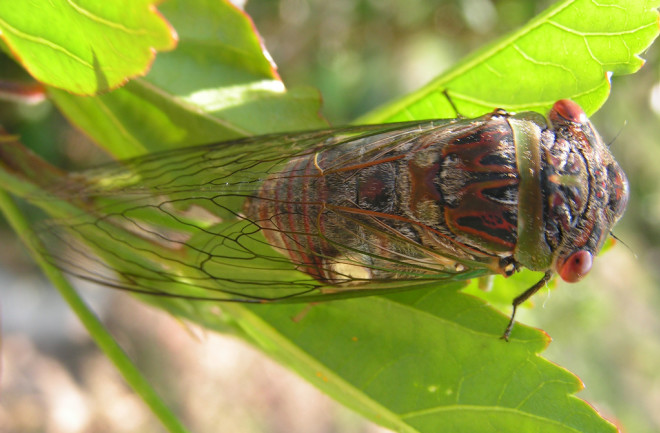When you think of cicadas, the first thing that likely comes to mind is that they emerge in 13-year or 17-year cycles and that they love to scream to find love. Though their mating call may not be unique — frogs, birds, and even howler monkeys have loud mating calls — a unique trait of cicadas is their ability to keep their wings clean. These wing-cleaning traits have inspired scientists to develop technology to keep our surfaces clear of dust, frost, and even bacteria.
How Cicadas Clean Their Wings
Though it’s impossible to see with the naked eye, cicada wings are made up of tiny, waxy cones called nanopillars. These cones help water, such as morning dew, gather on their wings and roll off, taking dust and debris with it.
Smaller water droplets combine with other smaller droplets, pulling the debris with it as they merge. Thanks to the water’s surface tension, the debris stays inside the water droplet. As the droplets merge and form larger drops, they roll off the cicada wings faster and easier, taking more debris as they go.
This self-cleaning method is known as super-hydrophobicity and has inspired researchers to look into how humans could use this method to keep windows and windshields clean. According to researchers from this 2023 study, not only could a design based on cicada wings keep dust, pollen, and dirt from forming on skyscraper windows and car windshields, but this method could also prevent them from frosting up.
Read More: Do Insects Have Feelings and Consciousness?
The Anti-Bacterial Effects of Cicada Wings
Besides removing dust, pollen, and other debris, cicada wings are also excellent at killing bacteria.
When study authors of a 2023 study published in Scientific Reports analyzed cicada wings, they discussed how they could use a replica of the wings' nanopillars to create bacteria-free surfaces such as door knobs, food preparation areas, and even certain medical tools.
The researchers discovered the nanopillars on cicada wings are topped with sharp points that pierce the bacteria’s cell membrane, essentially killing the bacteria.
An unrelated 2022 study from RMIT University looked at how cicada and dragonfly wings (which also have nanopillars) have inspired the creation of bacteria-free food packaging to prevent food loss during shipping.
According to the RMIT University study, “More than 30 percent of food produced for human consumption becomes waste, with entire shipments rejected if bacterial growth is detected.”
The hope is to one day create plastic packaging with replica nano textures — from the insect wings — that prevent the growth of bacteria on food products as they are shipped around the world. Reducing food waste ensures that more people are provided with quality food and helps prevent economic loss.
As the summer heats up in 2024, cicadas will begin to scream. And these screaming cicadas could one day be the reason you don’t have to scrape ice off of your windshield or get a bacterial infection.
Read More: The Emergence of Brood X Cicadas
Article Sources:
Our writers at Discovermagazine.com use peer-reviewed studies and high-quality sources for our articles, and our editors review for scientific accuracy and editorial standards. Review the sources used below for this article:
Nano Lett.Contaminant Removal from Nature’s Self-Cleaning Surfaces
Scientific Reports. Bio-inspired antimicrobial surfaces fabricated by glancing angle deposition
ACS Appl. Nano Mater. Nanopillar Polymer Films as Antibacterial Packaging Materials

